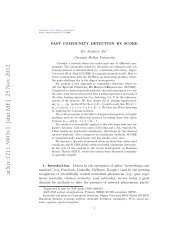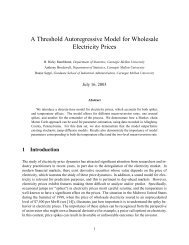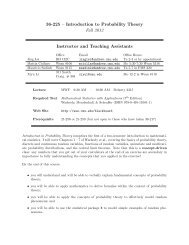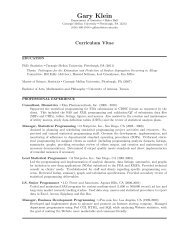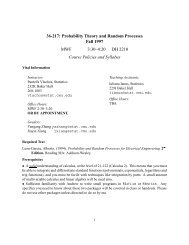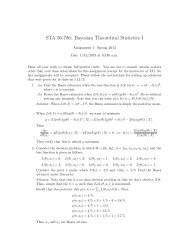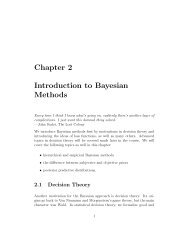Subjective Bayesian Analysis: Principles and Practice
Subjective Bayesian Analysis: Principles and Practice
Subjective Bayesian Analysis: Principles and Practice
Create successful ePaper yourself
Turn your PDF publications into a flip-book with our unique Google optimized e-Paper software.
This argument clarifies the logical status of a <strong>Bayesian</strong> analysis. It also frees us from the<br />
tyranny of conditioning. Even though (1) concerns probabilities, this relation can only be<br />
derived within a formalism which starts with expectation as primitive. In that formulation,<br />
probabilities are just expectation statements, <strong>and</strong> (1) is a special case of the following general<br />
result. Suppose that D is a vector of quantities which will be observed by time t. Given TSP,<br />
your current beliefs about your posterior expectation E t (X) for any other r<strong>and</strong>om vector X,<br />
specified at time t, must satisfy the following relations:<br />
where E D (X) is the Bayes linear mean for X determined by<br />
X = E t (X) + S (2)<br />
E t (X) = E D (X) + R (3)<br />
E D (X) = E(X) + Cov(X, D)(Var(D)) −1 (D − E(D)<br />
<strong>and</strong> R, S are further r<strong>and</strong>om quantities, with<br />
E(R) = E(S) = Cov(R, D) = Cov(S, D) = Cov(R, S) = Cov(S, E t (X)) = 0<br />
The Bayes linear analysis is based on direct specification of means, variances <strong>and</strong> covariances;<br />
for an overview of the Bayes linear approach to statistics see [7]. From (2), (3), the<br />
Bayes linear analysis for X bears the same relation to the actual posterior judgement for X<br />
that the posterior judgement for X bears to the quantity X itself. <strong>Bayesian</strong> conditioning is<br />
simply the special case of (3) in which D comprises the indicator functions for a partition.<br />
If conditioning is not the operation underpinning the <strong>Bayesian</strong> analysis, then the requirement<br />
of full probabilistic specification can be seen as an arbitrary imposition. We may<br />
make full probabilistic specifications where this is natural <strong>and</strong> straightforward, <strong>and</strong>, this<br />
representation will maximise the proportion of uncertainty expressed by E D (X). However,<br />
this is a refinement of degree, not of kind. If the extra information is worth the effort in<br />
prior specification <strong>and</strong> analysis that is required, then the full Bayes approach is worthwhile.<br />
Otherwise a simpler analysis is appropriate. Placing the subjectivist analysis within a logical<br />
framework which distinguishes between the model for the inference <strong>and</strong> the actual inference<br />
gives us control of the level of detail of our prior specification <strong>and</strong> analysis, while reminding<br />
us of the requirement to relate the formal analysis to the larger inferential problem which<br />
should always be our primary concern. Of course, this raises further questions as to precisely<br />
how such inferences should be conducted. This is largely unexplored territory; for theoretical<br />
underpinnings embedding statistical models derived from exchangeability judgements within<br />
this more fully subjectivist view, see [5]. Subjectivist theory offers a language <strong>and</strong> framework<br />
rather than a complete description of belief representation <strong>and</strong> inference. Whether such a<br />
complete description could ever be provided is, in my subjective opinion, extremely doubtful.<br />
5 Concluding comments<br />
The subjective Bayes approach is alive <strong>and</strong> well <strong>and</strong> proving very successful in many important<br />
practical applications. However, much of the potential of the approach is still to<br />
be realised. Subjectivist analysis may appear daunting, but, of course, what is difficult is<br />
making reasoned judgements about complex situations within any framework at all. The<br />
subjectivist approach does not make these difficulties vanish, but it does offer a coherent<br />
language <strong>and</strong> tool set for analysing all of the uncertainties in complicated problems, <strong>and</strong><br />
therefore provides the best method that I know for analysing uncertainty in important real<br />
12



